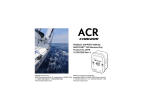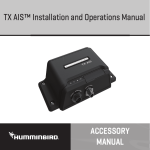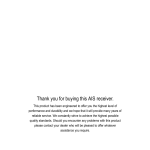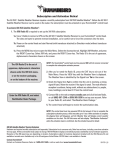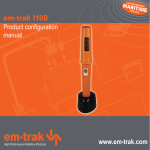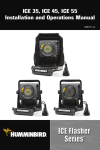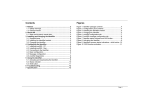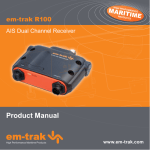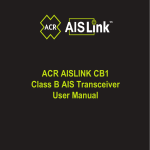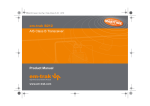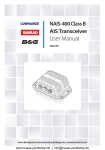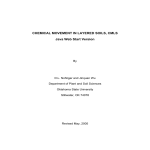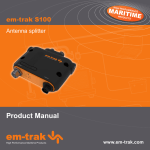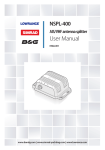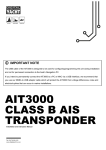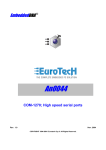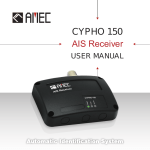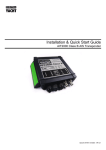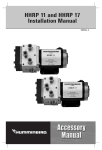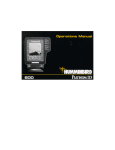Download RX_AIS_Manual
Transcript
RX AIS™ Installation and Operations Manual ACCESSORY MANUAL Thank you! Thank you for choosing Humminbird®, the #1 name in marine electronics. Humminbird has built its reputation by designing and manufacturing top quality, thoroughly reliable marine equipment. Your Humminbird is designed for trouble-free use in even the harshest marine environment. In the unlikely event that your Humminbird does require repairs, we offer an exclusive Service Policy. For complete details, see the separate warranty card included with your unit. We encourage you to read this manual carefully in order to get the full benefit from all the features and applications of your Humminbird product. Contact Humminbird Customer Service at humminbird.com or call 1-800-633-1468. Humminbird® is a registered trademark of Johnson Outdoors Marine Electronics, Inc. NMEA 2000® is a registered trademark of the National Marine Electronics Association. Table of contents Table of figures 1 1.1 1.2 1.3 2 2.1 2.2 3 3.1 3.2 4 4.1 4.2 5 6 Figure 1 Figure 2 Figure 3 Figure 4 Figure 5 Figure 6 Figure 7 Figure 8 Table 1 Figure 9 Figure 19 Figure 11 Figure 12 Figure 13 Notices ......................................................................................... 1 Safety warnings......................................................................................... 1 Using the USB Connection ..................................................................... 2 General notices.......................................................................................... 2 About your AIS receiver .............................................................. 7 About AIS ..................................................................................................... 7 What's in the box?.................................................................................... 8 Installation ................................................................................12 Preparing for installation......................................................................12 Installation procedures .........................................................................14 Operation ...................................................................................25 Using the AIS receiver............................................................................25 Indicator functions .................................................................................26 Troubleshooting ........................................................................27 Specifications ...........................................................................28 Items included with the product....................................... 8 AIS receiver overview ......................................................... 10 Electrical connections to the AIS receiver .................. 11 Typical installation ............................................................. 12 AIS receiver dimensions ................................................... 15 AIS receiver mounting....................................................... 16 Position of the VHF antenna connector ...................... 17 Position of the Power and Data connector................. 18 Colour coding of wires in the accessory cable........... 19 Connecting to the NMEA 0183 data port .................... 20 NMEA 2000 Connection .................................................... 21 USB Connection .................................................................. 22 Connecting the power supply ......................................... 24 Indicator location on the AIS receiver unit.................. 26 Notices 1 Notices ! When reading this manual please pay attention to warnings marked with the warning triangle shown on the left. These are important messages for safety, installation, and usage of the product. 1.1 Safety warnings ! This equipment must be installed in accordance with the instructions provided in this manual. This equipment is intended as an aid to navigation and is not a replacement for proper navigational judgement. ! ! ! ! Page 1 This AIS receiver is an aid to navigation and must not be relied upon to provide accurate navigation information. AIS is not a replacement for vigilant human lookouts and other navigation aids such as RADAR. The performance of the AIS receiver may be seriously impaired if not installed as instructed in the user manual, or due to other factors such as weather and/or nearby transmitting devices. Compatibility with other systems may vary and is reliant on the third party systems recognizing the standard outputs from the AIS receiver. The manufacturer reserves the right to update and change these specifications at any time and without notice. Do not install this equipment in a flammable atmosphere such as in an engine room or near to fuel tanks. This device should not be used as a navigational aid to prevent collision, grounding, vessel damage, or personal injury. When the vessel is moving, water depth may change too quickly to allow time for you to react. Always operate the vessel at very slow speeds if you suspect shallow water or submerged objects. Notices 1.2 Using the USB Connection ! The USB port built into this product is not isolated from the vessel power supply, VHF antenna ground or GPS Ground. Please observe the following procedures when connecting the USB port to avoid grounding problems. If the computer is permanently installed on the vessel and/or electrically connected to any other vessel equipment, including power supplies, it is recommended that connection is made using the NMEA 0183 or NMEA 2000 interfaces. These benefit from being specifically designed for use in the marine environment and provide isolated and robust communication between your devices. If a battery powered laptop is being used, then it is recommended that you always switch off the computer before connecting the USB cable. 1.3 General notices Compass safe distance The compass safe distance of this unit is 0.5m or greater for 0.3° deviation. RF emissions notice ! ! Warning! The AIS receiver generates and radiates radio frequency electromagnetic energy. This equipment must be installed and operated according to the instructions contained in this manual. Failure to do so can result in personal injury and/or AIS receiver malfunction. Warning! The antenna should not be co-located or operated in conjunction with any other transmitting antenna. The required antenna impedance is 50Ω. Page 2 Notices Warranty The product is supplied with standard warranty as defined in the Warranty statement supplied with the product. ! Disassembly and repair of this electronic unit should only be performed by authorized service personnel. Any modification of the serial number or attempt to repair the original equipment or accessories by unauthorized individuals will void the warranty. FCC Notice NOTE: This equipment has been tested and found to comply with the limits for a Class B digital device, pursuant to part 15 of the FCC Rules. These limits are designed to provide reasonable protection against harmful interference in a residential installation. This equipment generates, uses and can radiate radio frequency energy and, if not installed and used in accordance with the instructions, may cause harmful interference to radio communications. However, there is no guarantee that interference will not occur in a particular installation. If this equipment does cause harmful interference to radio or television reception, which can be determined by turning the equipment off and on, the user is encouraged to try to correct the interference by one or more of the following measures: - Reorient or relocate the receiving antenna. - Increase the separation between the equipment and receiver. - Connect the equipment into an outlet on a circuit different from that to which the receiver is connected. - Consult the dealer or an experienced radio/TV technician for help. This device complies with part 15 of the FCC Rules. Operation is subject to the following two conditions: 1. This device may not cause harmful interference, and Page 3 Notices 2. This device must accept any interference received, including interference that may cause undesired operation. Industry Canada Notice This device complies with Industry Canada licence-exempt RSS standard(s). Operation is subject to the following two conditions: 1. This device may not cause interference, and 2. This device must accept any interference, including interference that may cause undesired operation of the device. This Class B digital apparatus complies with Canadian ICES-003. Le présent appareil est conforme aux CNR d'Industrie Canada applicables aux appareils radio exempts de licence. L'exploitation est autorisée aux deux conditions suivantes: 1. L'appareil ne doit pas produire de brouillage, et 2. L'utilisateur de l'appareil doit accepter tout brouillage radioélectrique subi, même si le brouillage est susceptible d'en compromettre le fonctionnement. Cet appareil numérique de la classe B est conforme à la norme NMB-003 du Canada. Disposal of this product and packaging Please dispose of the AIS receiver in accordance with the European WEEE Directive or with the applicable local regulations for disposal of electrical equipment. Every effort has been made to ensure the packaging for this product is recyclable. Please dispose of the packaging in an environmentally friendly manner. Accuracy of this manual The AIS receiver may be upgraded from time to time, and future versions of the AIS receiver may therefore not correspond exactly with this manual. Information in this manual is liable to change Page 4 Notices without notice. The manufacturer of this product disclaims any liability for consequences arising from omissions or inaccuracies in this manual and any other documentation provided with this product. This manual was written in English and may have been translated to another language. Humminbird is not responsible for incorrect translations or discrepancies between documents. ROHS Statement Product designed and intended as a fixed installation or part of a system in a vessel may be considered beyond the scope of Directive 2002/95/EC of the European Parliament and of the Council of 27 January 2003 on the restriction of the use of certain hazardous substances in electrical and electronic equipment. Attention International Customers Products sold in the U.S. are not intended for use in the international market. Humminbird international units provide international features and are designed to meet country and regional regulations. Languages, maps, time zones, units of measurement, and warranty are examples of features that are customized for Humminbird international units purchased through our authorized international distributors. To obtain a list of authorized international distributors, please visit our Web site at humminbird.com or contact Humminbird Customer Service at (334) 687-6613. Environmental Compliance Statement It is the intention of Johnson Outdoors Marine Electronics, Inc. to be a responsible corporate citizen, operating in compliance with known and applicable environmental regulations, and a good neighbor in the communities where we make or sell our products. WEEE Directive EU Directive 2002/96/EC “Waste of Electrical and Electronic Equipment Directive (WEEE)” impacts most distributors, sellers, and manufacturers of consumer electronics in the European Union. The WEEE Directive requires the producer of consumer electronics to take responsibility for the management of waste from their products to achieve environmentally responsible disposal during the product life cycle. Page 5 Notices WEEE compliance may not be required in your location for electrical and electronic equipment (EEE), nor may it be required for EEE designed and intended as fixed or temporary installation in transportation vehicles such as automobiles, aircraft, and boats. In some European Union member states, these vehicles are considered outside the scope of the Directive, and EEE for those applications can be considered excluded from the WEEE Directive requirement. This symbol (WEEE wheelie bin) on product indicates the product must not be disposed of with other household refuse. It must be disposed of and collected for recycling and recovery of waste EEE. Johnson Outdoors Marine Electronics, Inc. will mark all EEE products in accordance with the WEEE Directive. It is our goal to comply in the collection, treatment, recovery, and environmentally sound disposal of those products; however these requirements do vary within European Union member states. For more information about where you should dispose of your waste equipment for recycling and recovery and/or your European Union member state requirements, please contact your dealer or distributor from which your product was purchased. Page 6 About your AIS receiver 2 About your AIS receiver 2.1 About AIS The marine Automatic Identification System (AIS) is a location and vessel information reporting system. It allows vessels equipped with AIS to automatically and dynamically share and regularly update their position, speed, course and other information such as vessel identity with similarly equipped vessels. Position is derived from the Global Positioning System (GPS) and communication between vessels is by Very High Frequency (VHF) digital transmissions. There are a number of types of AIS devices as follows: • Class A transceivers. These are similar to class B transceivers, but are designed to be fitted to large vessels such as cargo ships and large passenger vessels. Class A transceivers transmit at a higher VHF signal power than class B transceivers and therefore can be received by more distant vessels. They also transmit more frequently. Class A transceivers are mandatory on all vessels over 300 gross tonnes on international voyages and certain types of passenger vessels under SOLAS regulations. • Class B transceivers. Similar to class A transceivers in many ways, but are normally lower cost due to the less stringent performance requirements. Class B transceivers transmit at a lower power and at a lower reporting rate than class A transceivers. • AIS base stations. AIS base stations are used by Vessel Traffic Systems to monitor and control the transmissions of AIS transceivers. • Aids to Navigation (AtoN) transceivers. AtoN’s are transceivers mounted on buoys or other hazards to shipping which transmit details of their location to the surrounding vessels. • AIS receivers. AIS receivers will generally receive transmissions from class A transceivers, class B transceivers, AtoNs and AIS base stations but do not transmit any information about the vessel on which they are installed. This product is an AIS receiver. Page 7 About your AIS receiver 2.2 What's in the box? Figure 1 shows the items included with your AIS receiver purchase. The following sections give a brief overview of each item. Please ensure all items are present, and if any of the items are not present, contact Humminbird Customer Service. Dual channel AIS receiver Product manual Quick start guide Warranty information Screws (packet of 4) Product CD USB configuration cable Figure 1 Power and data cable Items included with the product Page 8 About your AIS receiver • Support tools CD The CD supplied with the package contains the USB drivers to enable use of the AIS receiver via its USB interface. Also included on the CD is the product manual in other languages. • Quick start guide The quick start guide provides a one page reference for the installation process. • Product manual This document is the product manual and should be read thoroughly prior to any attempt to install or use the AIS receiver. • Fixing screws Four fixing screws are provided with the product for mounting of the AIS receiver. Please refer to Section 3.2 for details of how to mount the AIS receiver. • AIS receiver unit Figure 2 shows an overview of the AIS receiver unit. The AIS receiver has an indicator which provides information to the user about the status of the AIS receiver. Please refer to Section 4.2 for more details of the indicator functions. • Power and data cable The accessory cable provides connections to the AIS receiver for power supply and NMEA 0183. • USB cable The USB cable provides connections to a PC or Mac. Page 9 About your AIS receiver . Indicator lights VHF antenna Mounting holes Mounting holes Power and data Access to USB connector NMEA 2000 Figure 2 AIS receiver overview Electrical connections The AIS receiver has the following electrical connections: • Power supply • NMEA 0183 data port for connection to chartplotters • USB for connection to a PC or Mac • NMEA 2000 port for connection to NMEA 2000 compatible equipment Page 10 About your AIS receiver Dual channel AIS receiver Power in NMEA 0183 device Chartplotter USB NMEA 2000 Figure 3 Page 11 Electrical connections to the AIS receiver Installation 3 Installation 3.1 Preparing for installation Figure 4 shows a typical installation configuration for the AIS receiver. Please take the time to familiarise yourself with the system elements and their connections prior to attempting installation. Chartplotter VHF antenna Dual channel AIS receiver Power in USB NMEA 0183 device NMEA 2000 Figure 4 Typical installation Page 12 Installation In addition to the items provided with your AIS receiver, the following items will be required for installation: VHF antenna Connection to a suitable VHF antenna will be required for the AIS receiver to operate. A standard marine band VHF antenna such as that used with VHF voice radios will be sufficient. Please take note of the warnings in Section 1 regarding the use of antennas. Alternatively, if you wish to use an existing VHF antenna, antenna splitter products are available which allow the existing antenna to be used with two radio devices, such as a VHF voice radio and the AIS receiver. Antenna cables Please check that the VHF antenna you intend to use has sufficient cable to reach between the VHF antenna and the AIS receiver unit. If it is not sufficient you will need an extension cable. Please contact Humminbird Customer Service for details of suitable products. For reference the VHF antenna connector type on the AIS receiver unit is SO239, and it is intended to mate with a PL259 connector. Power and data cables The AIS receiver unit is supplied with a two meter long power and data cable, and the AIS receiver unit is supplied with a two meter long power and data cable. If you require longer cables to reach your power supply, please ensure the cables are capable of carrying an average current of up to 200mA. Means of connecting the cables together will also be required. The use of ScotchlokTM connectors is recommended for this purpose. Chartplotter To display received AIS position reports as other vessels on your chartplotter, you will need to connect your AIS receiver to your chartplotter. Please refer to the user manual supplied with your chartplotter for details of how to connect and configure your chartplotter for use with AIS devices. For general guidance your chartplotter should be configured to accept NMEA data at 38400 baud (sometimes Page 13 Installation referred to as 'NMEA HS' in the plotter configuration menu). You may also need to enable the display of AIS targets in the chart options. Connection to a PC or Mac If you choose to use a PC or Mac with suitable charting software to display received AIS messages as other vessels, this can be accomplished by connecting the USB connector directly to the PC or Mac. Your PC may require USB software drivers to connect to the AIS receiver and these can be found on the CD included with the product. 3.2 Installation procedures Before beginning installation of your AIS receiver, please ensure you have the necessary additional items as detailed in Section 3.1. It is strongly recommended that you read all of the instructions in this manual prior to installation. If after reading this manual you are unsure about any element of the installation process, please contact Humminbird Customer Service for advice. The following sections explain the installation process step by step for each of the main elements of the system. Step 1 - Installing the AIS receiver Please note the following guidelines when selecting a location for your AIS receiver: • The AIS receiver must be fitted in a location where it is at least 0.5m from a compass. • There should be adequate space around the AIS receiver for routing of cables. See Figure 5 for details of the AIS receiver dimensions. • The ambient temperature around the AIS receiver should be maintained between -25°C and +55°C. • The AIS receiver should not be located in a flammable or hazardous atmosphere such as in an engine room or near to fuel tanks. Page 14 Installation • The AIS receiver is fully waterproof to ingress protection rating IPx6, however it is recommended that the AIS receiver is not subjected to extended periods of exposure to spray or submersion. • It is recommended that the AIS receiver is installed in a 'below decks' environment. • It is acceptable to mount the AIS receiver either vertically or horizontally. • The product is supplied with four self tapping screws for attachment of the AIS receiver to a suitable surface. Please refer to Figure 6 for guidance. • The AIS receiver should be mounted in a location where the indicator is readily visible as this provides important information on the status of the AIS receiver. 57 mm 175 mm Figure 5 Page 15 AIS receiver dimensions 48 mm 100 mm 152 mm Installation Figure 6 AIS receiver mounting Step 2 - Connecting the VHF antenna 1 Route the cable from the VHF antenna to the AIS receiver, and connect it to the VHF connector on the AIS receiver as shown in Figure 7. A standard marine band VHF antenna or AIS antenna should be used with the AIS receiver. The connector type on the AIS receiver is SO239. Your chosen VHF antenna requires a PL259 connector to Page 16 Installation mate with this. If your VHF antenna does not use this type of connector, please contact Humminbird Customer Service for details of available adaptors. NMEA 2000 VHF antenna Figure 7 Page 17 Position of the VHF antenna connector Power and data Installation Step 3 - Connecting the accessory cable VHF antenna Power and data Figure 8 NMEA 2000 Position of the Power and Data connector An accessory cable is supplied with the product to provide connections to power and the NMEA 0183 data ports. The cable has a pre-moulded connector at one end, which should be connected to the connector on the unit marked 'PWR/DATA'. The other end of the cable has twelve colour coded bare wires ready for connection. Table 1 lists the function of each colour coded wire for reference. Wire colour Description Function Red Power in + Power supply connections Black Power in - Light Green Not used Orange Not used No connection Page 18 Installation Brown NMEA 0183 port 1 TX+ Blue NMEA 0183 port 1 TX- White NMEA 0183 port 1 RX+ Green NMEA 0183 port 1 RX- Purple NMEA 0183 port 2 TX+ Pink NMEA 0183 port 2 TX- Grey NMEA 0183 port 2 RX+ Yellow NMEA 0183 port 2 RX- Table 1 ! High speed NMEA 0183 port (38,400baud) intended for connection to chartplotters Low speed NMEA port (4,800baud) intended for connection to other NMEA 0183 compatible sensors for multiplexing of data to the chartplotter Colour coding of wires in the accessory cable Please check your wiring very carefully before applying power to the product. Failure to wire the product correctly could result in permanent damage. Step 4 - Connecting to NMEA 0183 compatible equipment The two independent NMEA 0183 data ports provide connection to your chartplotter and other NMEA 0183 compatible equipment. Each port consists of two wires colour coded as shown in Table 1 and in Figure 9. Connect the wires to the appropriate connections on your NMEA 0183 compatible equipment. Please refer to your equipment manual for more information. The AIS receiver has a high speed output port which operates at 38,400baud and a low speed input port which operates at 4,800baud. The high speed port is intended primarily to connect to a chartplotter, while the low speed port is intended to connect to other NMEA 0183 devices. A multiplexing feature is provided, which means any messages that are received via the low speed port Page 19 Installation are automatically transmitted via the high speed port. This is particularly useful when using a chartplotter having only a single NMEA 0183 port. As any other sensor (such as a gyro-compass) can be connected to the AIS receiver via the low speed port, and the AIS receiver can be connected via the high speed port to the chartplotter resulting in the chartplotter receiving both AIS information and heading information simultaneously. Configure your equipment to the correct baud rate. The baud rate is determined by the port you’ve chosen for connection. Red Black Light green Orange Power in + Power in – Not used Not used Brown Blue White Green Purple Pink Grey Yellow Figure 9 Transmit + Transmit – Receive + Receive – Transmit + Transmit – Receive + Receive – NMEA 0183 Port 1 38,400baud (chartplotter) NMEA 0183 Port 2 4,800baud (other NMEA 0183 device) Connecting to the NMEA 0183 data port Page 20 Installation Step 5 - Connection to an NMEA 2000 network (optional) VHF antenna Power and data NMEA 2000 Figure 10 NMEA 2000 Connection The AIS receiver can be connected to an NMEA 2000 network by a suitable NMEA 2000 network cable available from your local dealer. If your vessel has an NMEA 2000 network, please refer to the relevant documentation for your NMEA 2000 equipment. Once connected, and with your chartplotter also connected to your NMEA 2000 network, you can receive AIS targets on your chartplotter. Page 21 Installation Step 6 - USB Connection (optional) Figure 11 USB Connection The AIS receiver is supplied with a USB port for connection to a PC or Mac. The USB connector can be connected directly to the USB port on the PC or Mac via the supplied USB cable. To enable connection of the AIS receiver to a PC, use the product CD to install the USB drivers. Driver installation is typically not required for use with a Mac. To install the drivers please follow the steps below: 1. Insert the product CD into the PC and navigate to the USB drivers folder. 2. Double click the setup.exe file to launch the installer. 3. Follow the on-screen installation instructions to complete installation. 4. Once installed the AIS unit can be connected to the PC. The USB drivers will be installed automatically, and the AIS will appear as a new COM port device. Page 22 Installation 5. Select the AIS COM port and a baud rate of 38,400 in PC based navigation software to make use of the AIS data. ! If the USB connection is removed from the PC or Mac during use, you must reset the connection before further use. To reset the connection, disconnect and then reapply power to the AIS before closing and relaunching any PC or Mac applications using the USB connection. Finally, reconnect the USB cable between the PC or Mac and the AIS receiver. Step 7 - Connecting to a power supply The AIS receiver requires either a 12V or 24V power supply typically provided by the vessel's battery, or it can be powered via USB. It is recommended that crimped and soldered lugs are used to connect the AIS receiver to the power source. It is recommended that the power supply is connected via a suitable circuit breaker and/or 3A fuse block. 1. Connect the red wire to a 12V or 24V power supply positive terminal. 2. Connect the black wire to the supply negative terminal. Page 23 Installation Indicator lights Power (Green) Red AIS messagePower received in + Black (Amber) Power in – Light green Orange Not used Not used Brown Blue White Green Purple Pink Grey Yellow Transmit + Transmit – Receive + Receive – Transmit + Transmit – Receive + Receive – NMEA 0183 Port 1 38,400baud (chartplotter) NMEA 0183 Port 2 4,800baud (other NMEA 0183 device) Figure 12 Connecting the power supply Page 24 Operation 4 Operation 4.1 Using the AIS receiver Once the unit has been installed, it is ready for use. Providing other vessels with AIS transceivers installed are within radio range of your vessel, you should see their details appear on your chartplotter or PC. Specific details of how to configure your chartplotter to make use of the AIS receiver features will be provided in your chartplotter manual. If you are using charting software running on a PC, please refer to the instructions provided with your chart plotting software to configure it and display AIS information. Page 25 Operation 4.2 Indicator functions The AIS receiver includes a green power indicator light and an amber AIS reception indicator light as shown in Figure 13. The green indicator will illuminate when power is applied, and the amber indicator will flash on receipt of AIS messages. Indicator lights Power (Green) AIS message received (Amber) Figure 13 Indicator location on the AIS receiver unit Page 26 Troubleshooting 5 Troubleshooting Issue Possible cause and remedy No data is being received by the chartplotter • Confirm that the power supply is connected correctly. • Confirm that the connections to the chartplotter are correct. • Confirm that the VHF antenna is correctly connected in accordance with the instructions in the manual. The power illuminated • Confirm that the power supply is connected correctly. indicator is not The reception indicator is flashing but AIS targets are not displayed on the chartplotter • Confirm the chartplotter NMEA port configuration is set to receive AIS data. • Confirm the chartplotter display settings are configured to show AIS targets. • Consult the chartplotter manufacturers documentation. The power indicator is illuminated but the reception indicator is not flashing to indicate receipt of AIS messages • Confirm there are vessels equipped with AIS transceivers in your area. • Confirm the VHF antenna is correctly installed and connected. If the guidance given in the table above does not rectify the problem you are experiencing, please contact your dealer for further assistance. Page 27 Specifications 6 Specifications Parameter Value Dimensions 175 x 100 x 48 mm (L x W x H) Weight 250g (AIS receiver unit only) Power DC (9.6 - 31.2V) or USB powered Average power consumption <1W Current consumption <200mA at 12VDC Electrical interfaces USB NMEA 0183 38,400 baud output NMEA 0183 4,800 baud input NMEA 2000 LEN=1 Connectors VHF antenna connector (SO-239) USB type mini B connector NMEA 2000 standard connector 12 way power input / NMEA 0183 Dual channel receiver Fixed frequency reception at 161.975MHz and 162.025MHz Channel Bandwidth 25kHz Receiver Sensitivity Better than -112dBm at 20% Packet Error Rate Environmental Operating temperature: -25ºC to +55ºC Page 28 Specifications Ingress Protection rating ! IPx6 Product specifications and features are subject to change without notice. Power supply information for this product can be found on the ratings label which is fitted on the bottom case of the Humminbird Receiver. Page 29 CONTACT HUMMINBIRD Contact Humminbird Customer Service in any of the following ways: Web site: humminbird.com E-mail: [email protected] Telephone: 1-800-633-1468 Direct Shipping: Humminbird Service Department 678 Humminbird Lane Eufaula, AL 36027 USA Hours of Operation: Monday - Friday 8:00 a.m. to 4:30 p.m. [Central Standard Time] 201-0423:2


































